Beyond the tall corn
11/3/2021With Iowa no longer the beef capital, what are our state’s special foods?
My aunt and her family visited Iowa from Oregon in the late 1950s. They wanted to eat Iowa beef at every meal. Iowa beef had such a national reputation then that it was revered from New York to the west coast. Iowa even had high schools with nicknames like “Cattlefeeders” and “Packers.”
Things were already changing for Iowa cattle feeders when my cousins visited. Production dropped here considerably in the 1950s as the number of farms shrunk and the size of farms grew. When small and self-sufficient family farms were the paragon for good stewarding, farmers raised corn to feed to their cows. Corn-fed cows produced more USDA prime and choice grades, which were then considered the benchmark of good tasting steaks.
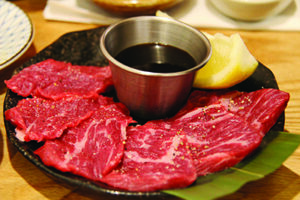
Wagyu beef is now considered to be the top of the line. While USDA prime has lost some of its luster. Photo by Lee Young Hee from Pixabay
Iowa has remained the leading corn producer, though last year’s derecho likely dropped our state behind Illinois. But the corn isn’t grown to feed animals as much as it used to be before industrial agriculture developed ethanol, high fructose corn syrup, toothpaste, shampoo, cereal, etc. Today, only 33% of corn goes to fuel animals while 57% becomes fuel for combustible engines. Also, because a bushel of corn adds nearly twice as much weight to a pig than to a cow, pork production now dwarfs beef production in Iowa.
We are far from the leading beef state today. In fact, we didn’t make the top 10 states in 2021. Texas became the leading cattle-producing state in the mid 1980s and has stayed No. 1. Texas leads Oklahoma, Missouri, Kansas, Nebraska, Montana and the Dakotas, but Iowa trails even Kentucky, Tennessee and Florida today according to World Population Review.
At the same time, prestige branding of beef has turned to breeds more than to USDA grading. Wagyu is the top of the line, and Angus mysteriously seems to mean more to brainwashed shoppers than USDA prime does. To be certified angus, a cow only needs to be half Angus.
Yet, while researching restaurants for an upcoming trip to Gatlinburg, Tennessee, a friend reported that “USDA graded Iowa beef” is still featured on her resort’s menu. AJ’s Steakhouse at Prairie Meadows Racetrack and Casino in Altoona advertises “USDA prime beef plus world-renowned Iowa pork and lamb.”
If beef is no longer Iowa’s most brandable quality food, what is? What do we produce that deserves the kind of aegis as “Michigan apples,” “Minnesota wild rice,” “California wine,” “Hawaiian tuna,” “New Mexican chilies,” “Texas barbecue,” “Montana trout,” “Alaska salmon,” “Florida citrus,” “Massachusetts clam chowder,” “Colorado peaches,” “Oregon marionberries,” “Idaho potatoes,” “Louisiana crawfish,” “Chesapeake oysters,” “Kentucky Bourbon” or “Carolina rice?”
We still have one of the highest percentages of both farmers and rich, black top soil. That helps Iowa produce several things that can’t be done better anywhere. So why don’t we market them more? What local Iowa foods are requested by out-of-state visitors and by nostalgic Iowans who have moved away?
Iowa Dairy
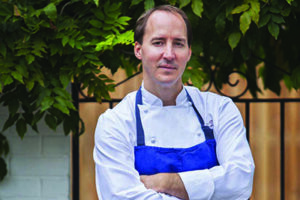
Eric Ziebolt has won multiple James Beard best chef awards. Since opening City Zen, a restaurant in Washington, D.C., he asks visitors from his old hometown of Ames to bring Anderson Erickson chive dip when they come.
Eric Ziebolt has won multiple James Beard best chef awards. He was Thomas Keller’s chef at The French Laundry in Napa and at Per Se in New York City. Then he went out on his own and opened City Zen and other places in Washington, D.C. He asks all visitors from his old hometown of Ames to bring Anderson Erickson chive dip when they come. He has even put a deconstructed version of it on his menus. Ziebolt is not the only one who craves AE dairy products. Keller insisted himself on trying some when he visited Des Moines. AE cottage cheese has a cult following, too.
Francis Thicke is a former USDA official who gave up bureaucracy to start a dairy farm in Jefferson County. Radiance Dairy is not your typical farm. The cows are treated to a lifestyle rarely seen since Lord Krishna himself herded cows. They are pampered with prairie grass and legume diets and allowed to free range. Their milk and cream are revered for their yellow color and rich taste.
Originally, Radiance marketed their milk in Des Moines and Iowa City, but it became so popular in Fairfield — the closest town to the dairy and home to a large population of meditators, vegetarians and Asians — that they sell out in that town alone now. Any foodie who knows about this stuff takes a large cooler along whenever passing through Fairfield. Picket Fence Creamery in Woodward raises its dairy cows much the same way as Radiance, and they are a player in the Des Moines market.
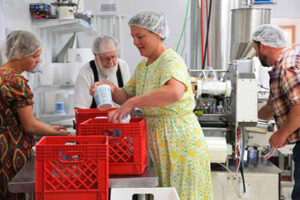
Country View Dairy in Hawkeye is a Mennonite family farm that makes Greek and American style yogurts, frozen yogurt, milk, and sour cream from organic cows.
Amish dairies like Kalona Super Natural, Country View and Milton Creamery have been fighting for their livelihoods since Kalona became the mega center of the nation’s most concentrated number of organic farms. There are 90 such farms within 10 miles of Kalona with most 25 years old or older, mostly raising dairy cows. In recent years, huge “organic” dairy farms have sprouted in Colorado, Arizona, Texas and New Mexico. The Kalona farmers have complained to the USDA that the western farms cheat the USDA’s standards for labeling “organic.” Mainly they don’t graze their cows whenever weather permits like Iowa farmers do.
That seems likely, too, because grazing huge herds requires huge pastures, and stats suggest the westerners don’t have enough land to do that, especially since the western states have extremely dry climates that make pasture much harder to grow. Five years ago, the Washington Post exposed the cheating, particularly at Aurora Organic in Colorado — the nation’s largest distributor of “organic” milk. They supply Costco, WalMart and Sam’s Club.
The Post exposure got a lot of attention, but the Amish complain that the USDA is still lax on enforcing standards and soft on penalties for cheats. Kalona dairy farmers are forced often to sell their superior milk for the same price as regular non-organic milk.
Country View Dairy in Hawkeye is a Mennonite family farm that makes Greek and American style yogurts, frozen yogurt, milk, and sour cream from their organic cows. Milton Creamery is in Van Buren County, which is Iowa’s most down-to-earth county and the only one in the state without a traffic light. Amish and Mennonite farmers there, and just south of there in Missouri, produce superior milk. Milton Creamery turns that into prize-winning cheeses, particularly their Prairie Breeze cheddar.
With the word “organic” becoming so abused in other states, why not market Iowa organic dairy products with the state’s name? In this case, it really means a lot.
Free range pork
Bill Niman is a Californian who seriously upgraded the quality of the beef and lamb he was raising in the 1970s and selling to the best restaurants in restaurant-crazed San Francisco Bay. In 1995, he met farmer Paul Willis of Thornton, Iowa. At the time, Paul was busy revitalizing sustainable hog farming methods in the Midwest, moving away from the common industrial practices. His dedication to animal welfare and stewardship of the land closely matched Niman’s stringent principles. A partnership was quickly formed. Originally Niman pork was all Iowa farmers. Now they also include some from neighboring states. Like Thicke’s dairy cows, these pigs live incredibly better than most. They have access to pasture and grow into a slowly raised absolutely delicious product.
Niman pigs are all heritage breeds, which produce a superior, old fashioned style flesh. Few industrial farm pigs use heritage. Willis says those pigs are raised to grow as fast as possible and look like they are on steroids. Willis likes to say that his pigs only have one bad day in their lives. Restaurants that sell Niman pork chops can trace a chop to a specific farmer.
Many expatriated Iowans plan an annual trip home in August because the tomatoes are ready. Many think that Iowa tomatoes are the best in the world, probably because of the rich black soil here. Because of Iowa tomatoes, bacon makers here have stepped up their game. Vande Rose of Iowa Falls has won America’s best bacon awards, and they subscribe to many of the same humane practices as Niman. Des Moines Bacon Company uses all local products in their production.
Herb and Kathy Eckhouse of Des Moines own La Quercia of Norwalk. That company usually challenges the best charcuterie makers in Spain and Italy for world’s best awards. The Eckhouses worked for years in Parma, Italy, which is renowned for its artisan approach to great food, particularly charcuterie and cheese. In Iowa, they tinkered for years trying to duplicate indoors what Parma has enjoyed for centuries — sea breezes at high altitude. Even in Parma now, most charcuterie is aged indoors. La Quercia only buys humanely raised hogs, and they encouraged one Iowa farmer to feed his pigs acorns, which, along with whey, made Parma prosciutto the most famous ham in the world.
Graziano’s Italian sausage has as devoted a following as any retail food in Iowa.
The tall corn state
Iowa remains best known for its corn. Our state song claims this is where the tall corn grows. As discussed above, the corn we grow today is mostly for cars and trucks, secondarily for pigs and cows and horses. Only 1 percent of the annual corn crop here is fit for human consumption, yet many Iowans consider sweet corn to be the No. 1 home-grown treat of the year.
Contemporary sweet corn is probably the most genetically reengineered food crop. That’s not all a bad thing. Anyone old enough to remember sweet corn before modern GMO corn (which began in 1996) recalls that it had little shelf life. Some farm stands would sell it, cook and serve it on picnic tables. That was because the corn began losing sweetness almost as soon as it was picked.
Today’s sweet corn lasts without noticeable deterioration for more than a week in the refrigerator. Sweet corn is what people purchase fresh, frozen or canned for eating. It’s consumed as a vegetable. Unlike “field corn,” which is harvested when the kernels are dry and fully mature, sweet corn is picked when immature. Iowa has more than 86,000 farms, and it ranks No. 1 in production of Dry Distillers Grain Solubles (DDGS) which serve as a premium source of protein for livestock. But most non-farmer Iowans really only are interested in the sweet corn.
The sweetest type of sweet corn is Mini Mirai. The most popular are Honey Select Hybrid, Jubilee Hybrid, Nirvana Hybrid, Peaches and Cream, Picasso Hybrid, Ruby Queen Hybrid and Silver Queen Hybrid. The most popular heirloom, non-GMO sweet corns are Blue Hopi and Stowell’s Evergreen. Much of the non-GMO corn in the U.S. is grown by Native Americans.
Iowa Corn Growers list these “fun corn facts”: Corn can be produced in various colors including blackish, bluish-gray, purple, green, red and white but the most common color grown is yellow; There is one silk for every kernel that grows in an ear of corn; The number of kernels per ear can vary from 500 to about 1,200, but a typical ear would have 800 kernels in 16 rows; Corn is grown in every continent except Antarctica; One acre of corn is about the size of a football field; A bushel of corn is 56 pounds, about the weight of a large bag of dog food; A single corn bushel can sweeten about 400 cans of soda pop.
You say tomato
If sweet corn isn’t the most anticipated home-grown food in Iowa, then tomatoes surely are. Unlike corn, heritage or heirloom varieties have been making comebacks in Iowa. Seed Savers Exchange in Decorah has influenced this movement. That organization lists the most popular heirloom cultivars as Italian Heirloom, Cherokee Purple, Nebraska Wedding, Dester, and German Pink. They can be cooked when green but some, like Green Zebras, are as sweet as red tomatoes.
Though tomatoes are fruits, they are often eaten like a vegetable in salad, on sandwiches, sliced alone or in sauces and salsas. No European had seen a tomato before one of Hernando Cortez’ captains rode into the Valley of Oaxaca. Because many people, including Ben Franklin, thought they were poisonous, it would take 200 years before they became popular in Italy.
Iowa’s climate and soil produce as fine a tomato as any place on Earth. Iowans notice that bacon prices usually reach their annual highs in homegrown tomato season. It’s hard to think of another sandwich so dear to Iowa’s heart as the bacon, lettuce and tomato.
The land of the turkey and the squash
Iowa has a rich history growing squash. Two of the best are even named for places in Iowa. The acorn, the most popular winter squash, is also known as Des Moines squash, and Iowa farmers have been growing it here since the 18th century. It came here from Denmark and was introduced as a seed in Des Moines in 1913, as the table queen.
Sibley squash was a native American cultivar first grown in the Missouri River Valley. With blue skin and orange flesh, squash guru Amy Goldman calls it the best of the banana squashes and she calls the banana squashes the superior types. It’s also a winter squash and, like the Des Moines squash, is a star attraction on Thanksgiving. Squash pies are a holiday treat. Nothing complements roast turkey better. Squash soups are becoming more popular with Iowa chefs each year.
Wild turkey is popular in Iowa now, and the state is one of the top turkey producers in America. Some farms here produce heirloom turkey breeds like Narragansett, Bourbon Red and Royal Palm. Those birds have stronger wing muscles and more dark meat than factory farm birds. ♦






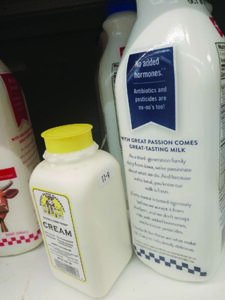
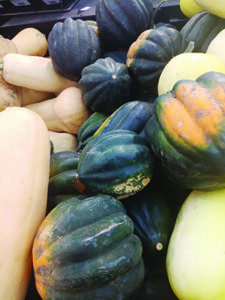















What a great article. What I’ve come to expect from Jim Duncan.